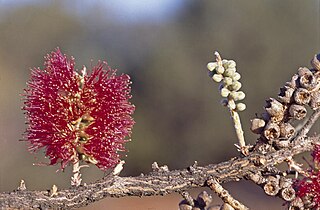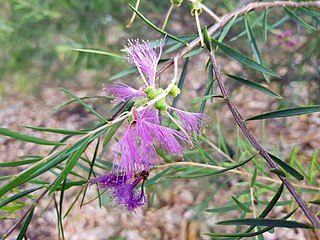Melaleuca penicula is a plant in the myrtle family, Myrtaceae and is endemic to the south of Western Australia. It is a rare species only known from the Fitzgerald River National Park and resembles Melaleuca eximia with its spikes of red flowers but its leaves and stamen bundles are different.
Melaleuca eximia is a plant in the myrtle family, Myrtaceae and is endemic to the south of Western Australia. It is distinguished by its leaf arrangement, its large, showy red inflorescences and the large, furry bracts under the flowers.

Melaleuca strobophylla is a shrub or small tree in the myrtle family Myrtaceae and is endemic to the south-west of Western Australia. It has papery bark, sharply pointed, twisted leaves and rather long spikes of creamy white flowers in summer.
Melaleuca adenostyla is a plant in the myrtle family, Myrtaceae and is endemic to the south-west of Western Australia. It is a large, broom-like shrub to about 5 metres (16 ft) high with narrow leaves and cream-coloured flowers and which often grows in saline places.

Melaleuca araucarioides is a plant in the myrtle family, Myrtaceae and is endemic to a small area of the south-west Western Australia. It is a many-branched shrub with the leaves arranged in a way that gives the plant the appearance of a conifer.

Melaleuca apostiba is a shrub in the myrtle family, Myrtaceae and is endemic to the south-west of Western Australia. It was first described in 1990 by Kirsten Cowley and remains a poorly known species. It resembles Melaleuca lateritia except for its hairy leaves and flower structures as well as its leaf shape and size.

Melaleuca coccinea, commonly known as the goldfields bottlebrush is a shrub in the myrtle family Myrtaceae and is endemic the south of Western Australia. It is distinguished by its unusual foliage and bottlebrush spikes of red flowers.
Melaleuca lecanantha is a plant in the myrtle family, Myrtaceae and is endemic to a small area of south-west Western Australia. It is a shrub with small, rather fleshy leaves and pink to lilac-coloured flowers in early spring. The plant was first described in 1867 but the name given to it was considered illegitimate and it was not until 1998 that it was first formally described.
Melaleuca fissurata is a plant in the myrtle family, Myrtaceae and is endemic to the south-west of Western Australia. It is a shrub with rough bark, dished leaves and heads of white or yellow flowers in spring. It is closely related to Melaleuca lateriflora but differs from it in having roughly textured, corky fruit and shorter, convex shaped leaves.
Melaleuca ochroma is a plant in the myrtle family, Myrtaceae, and is endemic to the south-west of Western Australia. It is very similar to Melaleuca subfalcata, varying mainly in the length of its stamens and styles. Like M. subfalcata, it has pink to mauve flowers and leaves that are very hairy when young but become glabrous when mature.

Melaleuca pomphostoma is a plant in the myrtle family, Myrtaceae, and is endemic to the south-west of Western Australia. It is a small, dense shrub with fleshy, narrow leaves, greenish-yellow flowers. It is similar and closely related to Melaleuca bracteosa but differs in the colour and number of stamens in each flower.
Melaleuca pritzelii is a plant in the myrtle family, Myrtaceae, and is endemic to the south-west of Western Australia. It was originally named in 1923 by Karel Domin as a subspecies Melaleuca densa var. pritzelii but raised to species status in 1992. It is a rare species, known only from a few plants in each of a small number of populations.

Melaleuca protrusa is a shrub in the myrtle family, Myrtaceae, and is endemic to the south-west of Western Australia. It is a shrub with papery bark, narrow leaves with a hooked end and cream-coloured or yellow flowers. Although it was described as late as 2010, it is not considered a rare or endangered species. It resembles other members of the brushwood group such as M. uncinata, M. atroviridis and M. zeteticorum.
Melaleuca sculponeata is a plant in the myrtle family, Myrtaceae, and is endemic to the south-west of Western Australia. It is a small, rare shrub with fleshy leaves and white heads of flowers.

Melaleuca spectabilis is a plant in the myrtle family, Myrtaceae, and is endemic to the south-west of Western Australia. It was formerly known as a subspecies of Melaleuca longistaminea. It is a low, prickly shrub with yellow or lime-green flowers in spring and early summer.

Melaleuca teuthidoides is a plant in the myrtle family, Myrtaceae and is endemic to the south of Western Australia. It is a shrub with rough bark and heads of white flowers on the ends of its branches in spring and early summer.

Melaleuca ulicoides is a plant in the myrtle family, Myrtaceae and is endemic to the south of Western Australia. It is a small, densely foliaged shrub with small heads of white or cream flowers in spring. It is closely related to Melaleuca marginata but can be distinguished from it by the number and character of leaf veins.
Melaleuca calcicola is a plant in the myrtle family, Myrtaceae and is endemic to the south of Western Australia. It was formerly known as a subspecies of Melaleuca apodocephala but was reassessed in 2010 and raised to species status. Its branches are corky, the leaves pointed although not prickly and the flowers are creamy white, tipped with yellow.
Melaleuca genialis is a plant in the myrtle family, Myrtaceae, and is endemic to the south-west of Western Australia. It is a rare species, known from one nature reserve. It is similar to Melaleuca tinkeri, mainly differing from it in having hairy leaves and petals.

Melaleuca fulgens subsp. steedmanii, commonly known as the scarlet honey myrtle, is a plant in the myrtle family, Myrtaceae and is endemic to the south-west of Western Australia. In 1990, the species Melaleuca fulgens was separated into 3 subspecies. Of the two subspecies occurring in the south-west, this one has the narrower distribution, occurring mainly near Geraldton. As with the other subspecies, this one is notable for its showy flowers which are usually red but its foliage and fruits are also attractive features.












